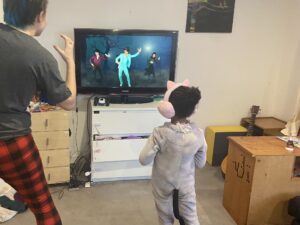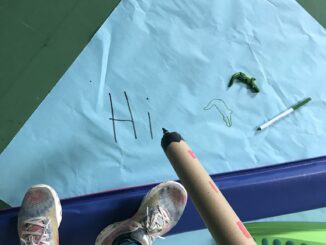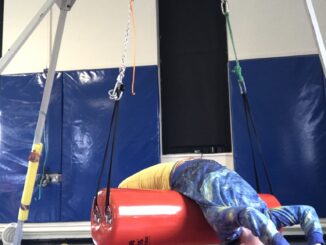We are currently on a VERY big Danny Go kick in my household, and I love them almost as much as my daughter does!
The elementary schools I work at love using Danny Go videos as “brain breaks” in between things, and it made me think I’d like to write more in depth about what exactly these videos are doing. Also, I might sound like I’m enthusing too hard to be genuine, but that’s just because I really like them that much — this is not like, anything sponsored or paid or anything like that.
There’s lots of things in Danny Go videos that anybody, at a glance, would love. They’re fun, they’re engaging, they’re right on kids’ level, they’re funny and clever and have enjoyable graphics. I thought about writing about my favorite videos, but there are so many, so instead I wanted to explain to you the elements that you might not know about at a glance — the movement opportunities that I see in lots of different Danny Go videos and why they’re important (in no particular order, just as they came to mind).
-Bilateral (two-handed) coordination
There is often something in the videos where you have to move both hands at the same time to do either the same thing, or two different things. Both of these are important skills. For example, pretending to climb up a ladder by reaching up with one hand, then the other, and alternating; copying/mirroring arm dance moves that are shown on “runes” as a password to open a magic door. Humans need to use both hands to do the same thing, or different things, like, all the time—everything from holding a paper steady while writing on it or cutting it with scissors, to driving a car!
-Left/right discrimination
The videos often have some kind of an element to “dodge” or “jump on” — in the river you have to jump from rock to rock on the left and right, a big snowman is throwing snowballs at you on the left and right, etc. They say aloud “left” and “right” while doing these, and demonstrate it on the screen for you to follow along with. There is also a lot of reaching out with your right hand and left hand to “grab” elements in the action videos, such as reaching out to pretend to grab a crystal. Teaching left/right in a play-based way is such a fantastic supporting skill for handwriting! Learning left and right helps learn where letters go on a page, which direction letters go, and which direction words go (among other things)!
-Interoceptive awareness
Interoception is your inner body sense, and becoming more aware of the sensations in your body is really important. Danny Go has comments throughout his lyrics, and modeled on the screen, that raise interoceptive awareness — from videos like Color Mix where kids are invited to choose which dance move reflects the way they’re feeling in their body, to modeling off handed sensory commentary like his reflections on what he hears and feels in Bouncing Time, to talking about using “bursts of energy” in Little Cat…there’s tons of interoceptive goodness both as-is and as launching off points for talking more in-depth with kids who need it more in-depth.
-Motor planning
Some people are naturally really good at looking at somebody else do something and then copying it themselves. Their brain takes in the visual input of watching the action be performed, and then their brain translates this visual input into what muscles the body will need to move in order to copy that input. Danny Go videos require kids to do a lot of motor planning, and Danny models with his body what movement the kids should do in order to join in with the motor planning. Plus, rewatching them over and over (one of my kids’ favorite things to do) gives a sense of accomplishment as the kids can predict and carry out an existing motor plan to do those movements, and practice watching on the screen and evaluating if they carried out that plan correctly. Then there are amazing songs like Color Mix where the song teaches you two different motor plans and then combines the motor plan into one, more complex motor plan, which does so much brain-growing-and-strengthening work in such a creative and clever way like I’ve never seen before!
-Core strengthening
Core strength — your trunk, your abdomen, your tummy and back muscles — has to be strong and steady before your arms and legs can be strong and have good control. When it comes to fine motor skills like handwriting, kids actually need to have a solid sensorimotor foundation first, then core strength on top of that, then total arm strength and stability, THEN they can have fine motor skills like handwriting. So, core strength is super important to me, and Danny Go gets loads of core strength work in, in fun ways. There are often obstacles you have to duck under or jump over in his “action videos”, like ducking under snowballs as you chase the Ice King or ducking under branches as you chase a tiger.
-Visual tracking
I am wary of how often these days kids’ visual tracking is primarily tied to visual input that comes from screens. I really try to emphasize and create opportunities for visual tracking that happens off-screen and with physically moving objects in real life, throughout play at home with my kids and throughout OT treatment. However, that said, visual tracking IS still an important skill — the skill of following an object with your eyes. It’s a skill that’s needed to be able to read, as you move your eyes across the page and smoothly process information as it comes in. It’s a skill that’s needed to be able to catch a ball, as you watch the ball coming toward you and then react with your muscles. It’s a skill that’s needed for a million things — scanning a room for some object you’re trying to find, all the way up to driving. And Danny Go has great opportunities for visual tracking with the action/adventure videos — a snowball rolling toward you, an upcoming obstacle you need to duck under or jump over or reach out for.
-Processing time
I like the pace of Danny Go videos. While still being fun, hyped, and engaging, with things like music that keep the energy up, the lyrics and the action are actually never at a hyper-fast pace like many types of kids’ media are. Neither are they the super slowed-down version that you sometimes see in preschool shows (and is age-appropriate for preschool shows!) where, for example, Daniel Tiger or Dora ask a question to the audience and then pause for a really long time. Danny Go is a little faster than those, but slower than most entertainment cartoons. If there’s a call-and-response component, there’s usually a pretty reasonable amount of pause time that feels good to me. If there’s an upcoming obstacle in an action/adventure video, or a direction like “move left” or “move right”, there’s lots of processing time before it happens. Kids need more processing time than most adults do, and Danny Go manages to do it without making it feel condescending.
-Visual, verbal, and kinetic cues
The video gives loads of types of cueing for the same direction or action. There will be a flashing arrow on the screen, at the same time that Danny says “move to the left!”, at the same time that Danny is moving his body to the left as well. This is so helpful for kids. For one, some people prefer to learn in different types of ways. For two, this gives more types of sensory streams incoming to kids’ brains and helps them connect and process the information more quickly. And it models for adults how to do the same thing.
I could probably go on and on, but that’s the list of things that first came to mind, and that are the OT-iest…I didn’t even touch on “the songs are super catchy” or “I want to wear Danny’s bright teal steampunk suit from the Skeleton Shake dance”. 😉
Here’s the other thing that I have to say. VIDEOS ARE NOT A REPLACEMENT FOR FREE, CHILD DIRECTED PLAY. Sorry for shouting. It’s just really important to me that I get across to everyone: Videos are *not* a replacement for free, child-directed play. Watching a YouTube video for five minutes in class in between sitting at desks for long periods of time is not a substitute for child-led learning through exploration and sensory engagement with the world. Watching ten YouTube videos in a row at home is not a replacement for going outdoors and moving your body in the world the way you want to do it.
But there’s still a place for things like this. And sometimes we can’t get to “perfect”, but we can get to “a little bit better”. Watching videos where we move our bodies has been a great replacement for watching passive cartoons where we *don’t* move our bodies, at my home, with me and my kid. Watching Danny Go has been a great connecting and bonding activity, as a replacement for “the two of us sitting in a room and not interacting with one another”. We even like Danny Go songs in the car, where they make a great replacement for “arguing in the backseat”. So I’m not here to demonize screens or watching videos, either. Danny Go is fabulous for the niche that it is, and I gotta be honest, I really like shaking all my bones. 🙂

[Image description: my daughter and I in my living room dancing along to the Skeleton Shake song. On the screen is a moment in the Danny Go video; I have my hand up in a claw like a werewolf since I’m doing the Werewolf Waltz (claws out swaying side to side!). My daughter is dressed in the obligatory Danny Go costume she puts on every time we watch, which consists of a unicorn onesie, cat tail, cat ear headphones. I’m dressed in pajamas. Our living room is cluttered. End description.]



